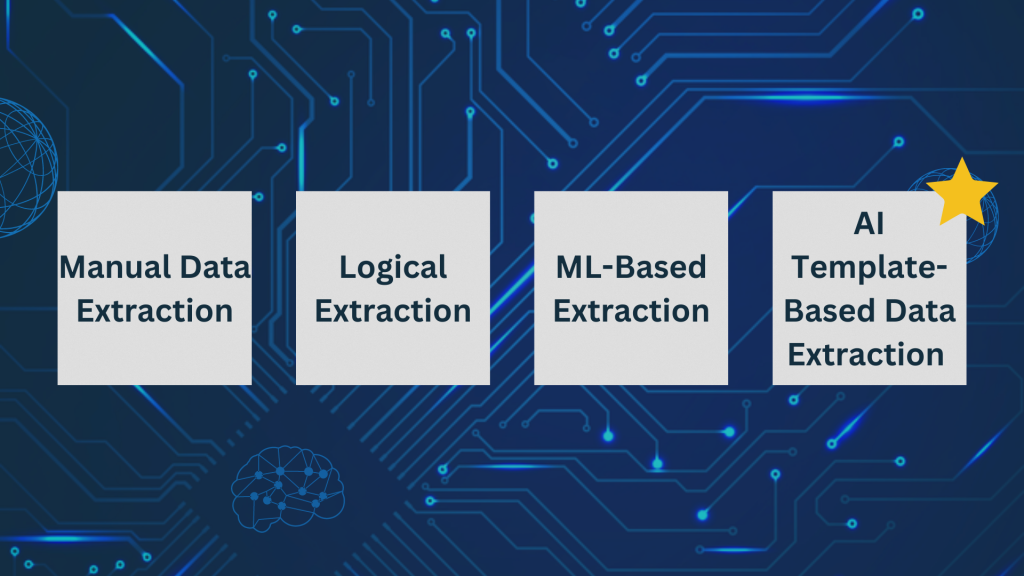
AI Template-Based Solutions: The Future of Data Extraction
Data extraction is a crucial part of any business dealing with large volumes of information and involves capturing data from various sources, such as invoices, receipts, contracts, and other documents. Manual data extraction can be tedious and prone to errors, while other automated data extraction techniques like logical extraction and machine learning-based extraction have their flaws (hint: inaccurate data!)
That’s where AI-powered data extraction with reusable template-based extraction comes in. It revolutionizes the way organizations process unstructured documents. In this blog post, we’ll discuss why template-based data extraction rules, and why it’s a better choice against manual and other automated data extraction techniques.
What is AI Template-Based Data Extraction?
AI template-based data extraction is a technique that involves using reusable templates to extract specific data fields and key-value pairs from a document. The template is created based on the structure and format of the document, and it includes fields for the data that needs to be extracted. Once the template is created, it can be reused for future documents with a similar structure and format.
The AI template-based approach allows organizations to automate document processing as the captured data becomes part of the data pipelines that feed data into their data warehouse. This means that the data can be easily accessed and used by reporting and analytical solutions, making it easier for your organization to make data-driven, informed decisions and ultimately increase the bottom line.

Why is AI Template-Based Data Extraction Better?
There are three primary alternatives to AI template-based data extraction: manual data extraction, logical extraction, and ML-based extraction. Let’s take a closer look at each of the alternatives to see how they compete with the template-based approach.
Manual Data Extraction
Manual data extraction involves manually reading and interpreting unstructured documents to extract data. This approach is sluggish, inefficient, and prone to human errors and subjectivity, which can lead to inaccuracies in the extracted data.
Additionally, manual data extraction is not scalable. It requires human resources to manually extract data from each document, rendering it costly and time-consuming (and even impractical!) for businesses managing vast volumes of data.
Logical Extraction
Logical extraction is a technique that uses logical rules to extract data from unstructured documents. It relies on defining manual rules or patterns that identify data elements within a document. However, this approach is not without its limitations.
For starters, defining the rules requires a high level of expertise and manual effort, which can be time-consuming and costly. Moreover, logical extraction is not scalable, as the rules must be manually created for each document type.
This approach is also susceptible to errors and inaccuracies, as it relies on the accuracy of the rules created. In addition, it’s unable to handle complex documents with multiple structures, thus constraining its applicability.
ML-Based Extraction
Machine learning (ML)-based extraction technique involves training a machine learning model to recognize patterns in unstructured documents, allowing it to extract relevant data automatically. It can be effective in some cases, but also has its drawbacks.
For starters, it requires large volumes of data to train the algorithms. The ML models can be computationally intensive, requiring significant processing power and time to train and execute.
In addition, this approach may not consistently deliver accurate results due to various factors such as insufficient training data, overfitting, inaccuracies in the model, and variations in the data.
The interpretability of the results can also be problematic, as it may not always be apparent how the ML model arrived at its decisions.
AI Template-Based Data Extraction
AI template-based data extraction offers several advantages over other data extraction techniques that we’ve seen above. First and foremost, it’s highly accurate as it eliminates the risk of human error. There’s no chance of typos, misspellings, and other errors that can affect the accuracy of the data. Moreover, it also eliminates the inherent risks that come with model training.
With AI template-based data extraction, the data is extracted precisely as it appears in the document, which ensures its accuracy.
Since the template is designed to extract specific data fields from a document, the extraction process is consistent across all documents with a similar structure and format. This ensures that the extracted data is consistent, which is crucial for businesses that rely on data for decision-making.
AI Template-based data extraction is also very efficient. With a reusable template, you can extract data from multiple documents in seconds, saving you time and resources. The templates can be adapted to different document types and formats to allow seamless data extraction from various unstructured documents such as invoices, receipts, contracts, and more.
AI Template-Based Data Extraction Use Cases
AI Template-based data extraction can be used in various industries, including finance, healthcare, and legal. Let’s look at a few real-life examples:
- Finance: Financial organizations use AI template-based data extraction to extract information from invoices, bank statements, loan applications, and other important financial documents. For example, a bank can create templates to extract the customer’s name, account number, transaction ID, date, and other relevant information from documents. This can help the bank streamline its processes, reduce errors, and improve its customer service.
- Healthcare: Healthcare providers can use AI template-based data extraction to extract patient information from medical records, insurance claims, and other healthcare documents. For example, a hospital can use a template to capture the patient’s name, age, medical history, diagnosis, and additional relevant information from a medical record. This can help the hospital improve patient care, reduce errors, and streamline operations.
- Legal: A law firm can use AI template-based data extraction to extract information from contracts, agreements, and other legal documents. For example, a law firm can use a template to extract the client’s name, the date of the agreement, the terms and conditions, and other relevant information from a contract. This can help the law firm reduce errors, save time, and improve its legal services.
A Final Word
AI-powered solutions with reusable template-based extraction are a game-changer for organizations dealing with large volumes of data. It offers several advantages over manual and other automated data extraction techniques, including accuracy, consistency, speed, and flexibility.
This approach can help businesses streamline document processing, reduce errors, and improve their services. If you’re looking for a reliable and efficient way to extract data from your documents, AI template-based data extraction is the way to go.
Astera ReportMiner is a cutting-edge AI-based data extraction tool that empowers you to extract data from unstructured documents at scale. Equipped with advanced AI Capture technology, our tool allows you to build reusable extraction templates in seconds.
Using ReportMiner, you can extract, cleanse, manipulate, and validate unstructured data and push them to data pipelines for seamless reporting and analytics.
Automate your unstructured data extraction workflow today!


